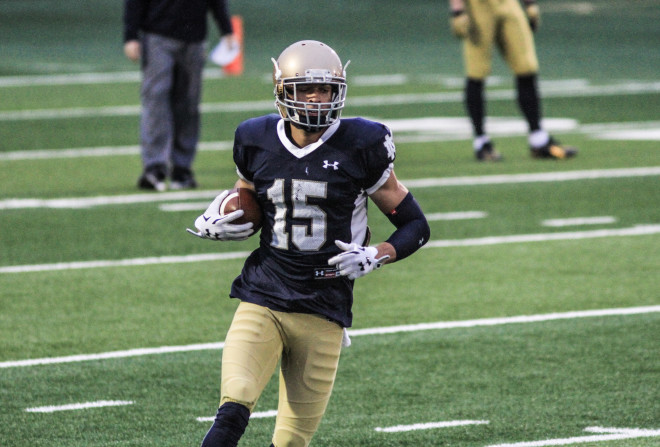Notre Dame Looking To Fit The Slot

Through head coach Brian Kelly’s first six seasons at Notre Dame, every pass catching position but one has featured a standout.
It started in 2010-11 with the boundary spot (referred to as the W) that showcased future NFL Draft first-round selection Michael Floyd, the all-time leading receiver in school history. His 6-3, 220-pound frame allowed him to have a physical advantage against smaller corners in the tighter spaces on the field.
Tight end featured another first-round figure in Tyler Eifert, followed by second-round pick Troy Niklas.
The past two years, the X receiver, which has more open space on the field side, utilized the speed/game-breaking skills of Will Fuller that could potentially make him a first-round pick this spring.
Meanwhile, the slot position, known as the Z, has remained mainly in the shadows. In the spread scheme Notre Dame runs, it is classified as a potential hybrid, or half running back, half receiver. That’s why when Kelly arrived in 2010, one of his first personnel moves was to shift running back Theo Riddick to the potential marquee slot to maximize his skills.
It worked out decently with Riddick hauling in 78 catches for 850 yards and six touchdowns there, but he was moved back to running back as a senior and starred there for the 12-1 team in 2012, where he rushed for 917 yards and still caught 36 passes.
Taking over at slot in 2012 was Robby Toma, who had the “prototype” 5-9 slippery, smaller frame to go with flypaper hands that could latch onto anything in the quick, short-to-intermediate passing game, a la NFL stars Wes Welker or Danny Amendola. Toma caught only 24 passes for 252 yards in 2012 — the fifth most on that team — but current receivers coach Mike Denbrock said Toma filled his role well for the offense to complement the rest of the attack.
“He could break people down in space,” Denbrock said. “Most of the time the slot is not going to get press [coverage] from the corner or safety, so he can get himself off the line of scrimmage and get into space to make plays.”
From 2013-15, Notre Dame went back to the Riddick-like running back route with Amir Carlisle, who originally signed with USC as a running back. During this time, the position also “broke the mold” by adding bigger or thicker figures such as 220-pound safety C.J. Prosise and 220-pound running back Will Mahone.
Consequently, what occurred is a rotation of sort at slot with different body types to attack different defensive sets. In 2014, Carlisle caught 23 passes for 309 yards and three scores, while his tag-team partner and the more physical Prosise (a former safety) snagged 29 for 516 yards and two touchdowns. That’s 52 combined catches at the position that averaged nearly 16 yards per grab.
Last year, with Prosise moving exclusively to running back — after all, the slot man should be versatile enough for such a task — it was Torii Hunter Jr. who became Carlisle’s tag-team partner, and the numbers at slot were similar. Carlisle latched on to 32 passes for 355 yards, while Hunter grabbed 28 for 363, giving the duo a total of 60 for 718 yards and three scores.
With Carlisle now graduated, Hunter being moved around (including Fuller’s old X position) and 5-8, 185-pound sophomore CJ Sanders (who has the archetype frame and skill set associated with the position as a receiver, runner and return man) sidelined several months after undergoing surgery for a hip flexor, Denbrock and the offense are searching for answers again at slot.
Landing Sanders’ “body type” for the spot in 2015 was important after missing out on two of its top prospects there in 2014: 5-8, 184-pound Isaiah McKenzie (who ended up at Georgia) and 5-11, 183-pound Michiah Quick (Oklahoma) — not that the physical frame is the most important requisite there.
“More than anything, we’re going to do things with that position that the body type —whatever concept, or route combination, or defensive body type that we have to play there,” Denbrock said. “If you want to be a little bit more of a vertical passing game, I think you want a little bigger body in the slot so the quarterback can see him with all the linemen around him and all the things going on.
“It just depends. It’s a pretty interchangeable position, so we feel like we can do a lot of things.”
Hunter is the safety valve at the position and will likely be used at all the wideout areas this year, much like 2013 team MVP TJ Jones was. That’s why 6-0½, 190-pound junior Corey Holmes, who has no career catches but was hand-timed with the fastest 40 on the team this winter (4.39), has been taking the reps at slot.
“I know he can play X, I know he can be the field No. 1 receiver,” Denbrock said of Holmes. “What we wanted to get a feel for him more than anything was is this guy who is versatile enough that we can use his speed in different spots? He’s showing some promise [at slot].”
With Sanders sidelined, 5-9¼, 175-pound sophomore walk-on Chris Finke has been working behind Holmes at slot, and he also is vying for a spot in the return game.
“He’s got to catch the ball a little more consistently,” Denbrock said of Finke. “He can run, though. That’s obviously a great attribute to have if you’re a wide receiver and you don’t have to worry about bump coverage by playing in the slot. … I’m not shutting the door on anybody.”
There’s always a slot to fill in this offense.